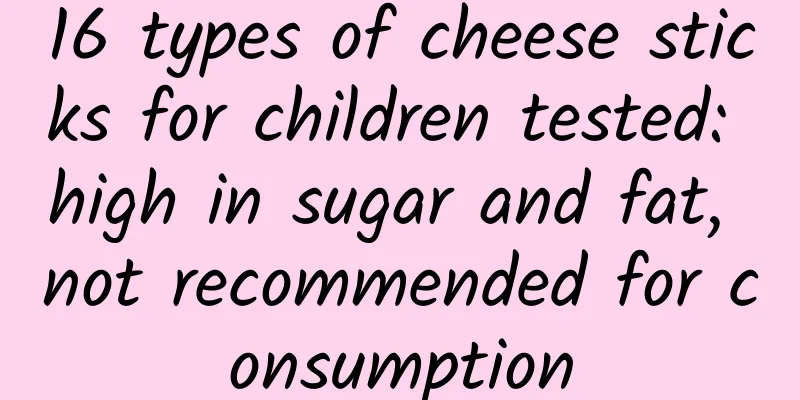16 types of cheese sticks for children tested: high in sugar and fat, not recommended for consumption

|
Have you ever bought cheese sticks for your kids? In the supermarket, there are a variety of children's cheese sticks on the shelves. The colorful cartoon packaging immediately catches the children's attention. In addition, the packaging is printed with cute cartoon images and the taste is sweet and fragrant. How can children not love such cheese sticks? Many parents believe that they cannot stop their children from eating snacks, and eating cheese sticks is always healthier than eating puffed foods. If children don't like to drink milk, they can eat cheese sticks, which can supplement calcium anyway. But are children's cheese sticks really as healthy as we think? This time, Dad's Review selected 16 children's cheese sticks that are popular on e-commerce platforms to take a look at them for everyone: The sample fee is 1704.72 yuan + the testing fee is 20352 yuan = 22056.72 yuan 1. Cheese sticks are processed cheese. First of all, we need to clarify the concept. Most children's cheese sticks are processed cheese. According to the national standard, the cheese content in processed cheese only needs to be greater than 15%, and the nutritional value of protein, calcium, etc. is far less than that of cheese. Take out a pack of cheese sticks and look at the ingredient list. The most common ingredient is water. The second is butter, and the third is cheese. Water, butter, cheese, sugar, skim milk powder and concentrated milk protein are the basic ingredients of cheese sticks. The ingredient list of food is arranged from most to least according to the amount added, that is, whichever ingredient is listed first, has the highest content. When buying children's cheese, try to choose the one with cheese listed first, which will be healthier. 2. Additives are not a small number. Continuing to study the ingredients list of children's cheese sticks, we found that there are also a lot of additives in it. But parents don't have to worry, food additives used in accordance with national regulations are not harmful to children's health. The additives in children's cheese are mainly to make the cheese taste better, prevent spoilage, and increase flavor. If you mind certain additives, just look at the ingredient list and avoid them when purchasing. We have to admit that additives make cheese sticks taste better, otherwise why would children be addicted to cheese sticks. During the review, we also asked the adults in the office to eat cheese sticks. Some people thought that they were full of milk flavor and tasted like jelly, and they couldn't stop eating them. However, there were also some fruit-flavored cheese sticks that did not contain any fruit or fruit products, and tasted stronger than essence. 3. After talking about the ingredients such as protein, fat and sugar, let’s talk about the nutritional components. Most parents buy cheese sticks because the merchants promote their high nutritional value and can supplement protein and calcium for children. Many brands also write on the product details page that the protein content of cheese sticks is several times that of milk. From this point of view, the protein content of cheese sticks is indeed quite high. However, we have to consider that drinking 100g of milk a day does not even reach the amount of a box. Eating 100g of cheese sticks, you need to eat about five sticks, which is a bit too much. You know, there is a lot of sugar and fat in cheese sticks. We collated the protein and fat content of 16 children's cheese sticks in the nutrition facts table and sent them to the laboratory for testing of total sugar content (using the AOAC 995.13 method). After getting the total sugar test results, we subtracted the lactose in dairy products to get the added sugar in children's cheese sticks. It is obvious that children's cheese sticks are high in protein, fat and added sugar: According to the National Dietary Reference Intake (DRIs 2013), children aged 3 to 6 years old need to consume 30g of protein per day, and the recommended total fat intake is about 27 to 48g. Regarding added sugars, the World Health Organization (WHO) recommends that adults and children consume no more than 25 grams of added sugars per day. It can be seen that children still need to rely on a balanced diet to get enough protein every day. If they want to supplement protein with cheese sticks, they will consume more fat and sugar. We calculated that eating three cheese sticks is close to half of a child's daily sugar intake. If you eat or drink other snacks or drinks, I'm afraid the sugar intake will exceed 25 grams. 4. Pay attention to the calcium-sodium ratio. Merchants promote children's cheese sticks as calcium supplements, which is the same routine as promoting protein supplements. But parents should note that during the production and processing of processed cheese, some additives containing sodium are often added to promote cheese formation, retain moisture, etc. When choosing cheese sticks, you need to weigh the calcium and sodium content. After all, we want our children to consume more calcium and less sodium. To determine the amount of calcium and sodium, you can look at the calcium-sodium ratio. A high ratio means that the child consumes less sodium when supplementing calcium. We sent 16 cheese sticks to the lab to test their calcium and sodium content and calculated the calcium-to-sodium ratio. Here are the results: GB 5009.268-2016 Method 1 & GB 5009.92-2016 Method 4 and GB 5009.268-2016 Method 1 & GB 5009.91-2017 were used respectively. If the calcium/sodium ratio of children's cheese sticks is less than 1, you should choose carefully. For example, No. 1, No. 2, No. 9, No. 13 and No. 14. Giving these cheese sticks to children will make them take in more sodium than the calcium they supplement. It is important to emphasize here that you should choose children's cheese sticks with a high calcium-sodium ratio. Having said so much, let’s finally teach you how to choose cheese. 1. When feeding cheese to children, it is recommended that you make sure the product type is cottage cheese. Cheese options include those recommended by the American Academy of Pediatrics: cheddar, mozzarella, Swiss, Parmesan, string cheese, and cottage cheese. We also know that it is difficult for Chinese people to adapt to the taste of cheese. To get children to eat cheese, parents need to be more careful when making it. 2. If you want to give your child cheese sticks, it is recommended not to exceed 3 sticks per day. 3. Whether it is cottage cheese or processed cheese, you should follow the principle of "two highs and two lows" when purchasing, that is, higher protein and calcium, lower fat and sodium, so that you will generally not make the wrong choice~ References: [1]https://www.healthychildren.org/English/healthy-living/nutrition/Pages/Fat-Salt-and-Sugar-Not-All-Bad.aspx [2] https://www.who.int/news/item/04-03-2015-who-calls-on-countries-to-reduce-sugars-intake-among-adults-and-children [3]https://www.healthychildren.org/English/healthy-living/nutrition/Pages/The-5-Food-Groups-Sample-Choices.aspx |
<<: One man's plan to resurrect the animals we can't save
>>: Some people devote their whole lives to the classification of small yellow flowers
Recommend
Analysis of process and thread scheduling in Android: nice
In computer operating systems, processes are the ...
In a mobile Internet company, what are the KPIs of each department?
KPI, or key performance indicator, is a performan...
Mushrooms growing on apples and garlic? A doctor from the Chinese Academy of Sciences bought and tasted them...
Edit: April Last month Zhejiang continues to expe...
Promotion strategy of Sina Weibo Fanstong
Someone told me that Sina Weibo’s scale is not up...
Xiaohongshu’s hot-selling notes trends!
There were Labor Day and other promotional events...
The bulge in your buttocks may not be your wallet? Beware of the pain deep inside your buttocks!
1. What is “thick wallet syndrome”? In the past, ...
Men only have 6,000 sexual intercourses in their lifetime? Should we abstain from sex?
As a urologist, I often receive inquiries like th...
In Shanghai, people are already eating cacti from flower pots
Editor's note: Calendar Girl recently receive...
Attention! What you are drinking may be Aspergillus flavus, not golden camellia tea!
China is not only a major tea producer, but also ...
Apple's App Store search rules have become dramatically more equal
Last week, the news that Apple CEO Tim Cook came ...
Tips for soft article placement!
There are a lot of people who know how to promote...
WeChat's latest blockbuster feature begins internal testing, two phones can log in to one account at the same time
The update speed of WeChat has slowed down a bit ...
The formula for hit products created by internet celebrities!
Li Ziqi became popular on YouTube. This is not cu...
Summary of predictions for new products at Apple's conference tonight
[[148415]] Apple will hold a new product launch e...
A product manager tells his own story: How to get recommended on the App Store homepage within a month?
Regarding the recommendation on the App Store hom...









